Abstract
The vertebrate Dlx gene family consists of homeobox-containing transcription factors distributed in pairs on the same chromosomes as the Hox genes. To investigate the evolutionary history of Dlx genes, we have cloned five new zebrafish family members and have provided additional sequence information for two mouse genes. Phylogenetic analyses of Dlx gene sequences considered in the context of their chromosomal arrangements suggest that an initial tandem duplication produced a linked pair of Dlx genes after the divergence of chordates and arthropods but prior to the divergence of tunicates and vertebrates. This pair of Dlx genes was then duplicated in the chromosomal events that led to the four clusters of Hox genes characteristic of bony fish and tetrapods. It is possible that a pair of Dlx genes linked to the Hoxc cluster has been lost from mammals. We were unable to distinguish between independent duplication and retention of the ancestral state of bony vertebrates to explain the presence of a greater number of Dlx genes in zebrafish than mammals. Determination of the linkage relationship of these additional zebrafish Dlx genes to Hox clusters should help resolve this issue.
Full text
PDF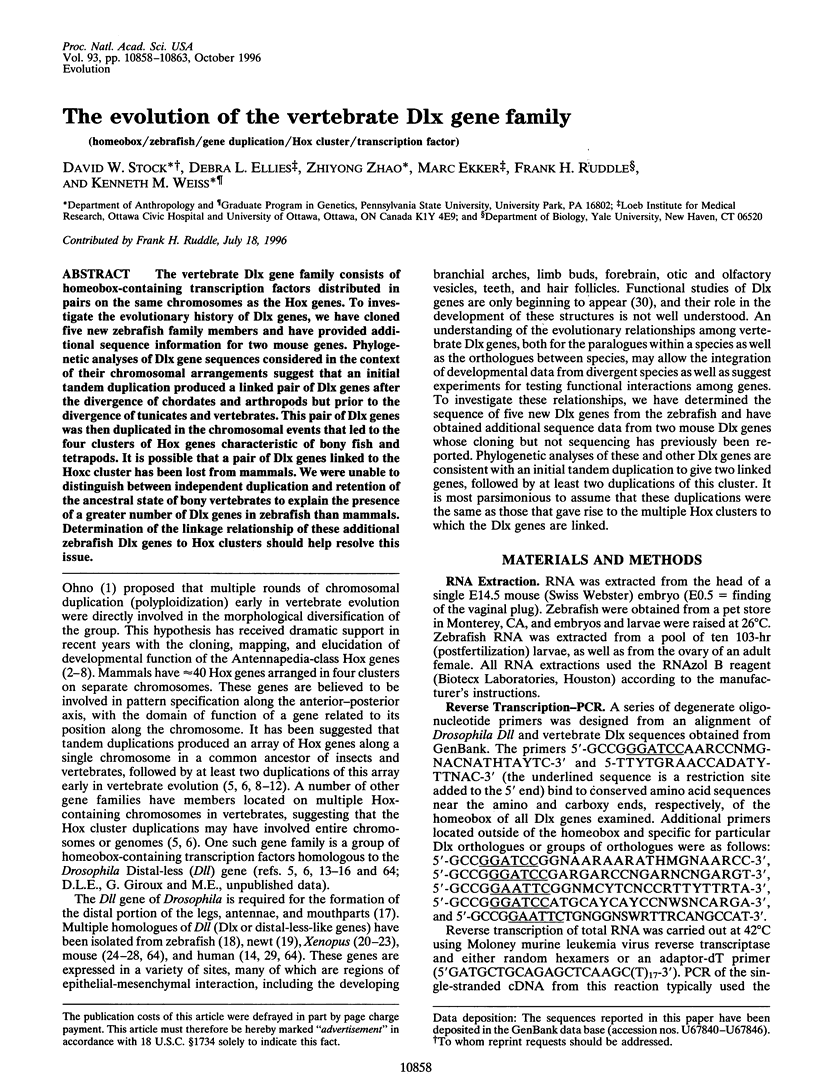
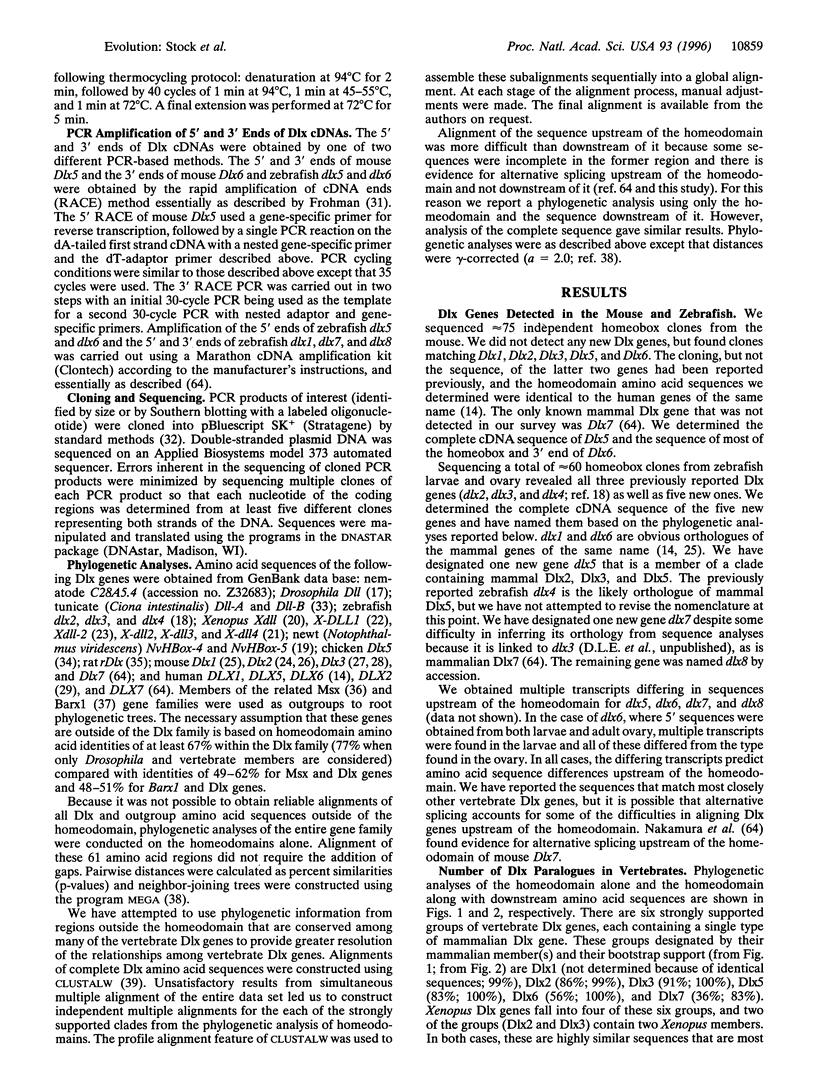
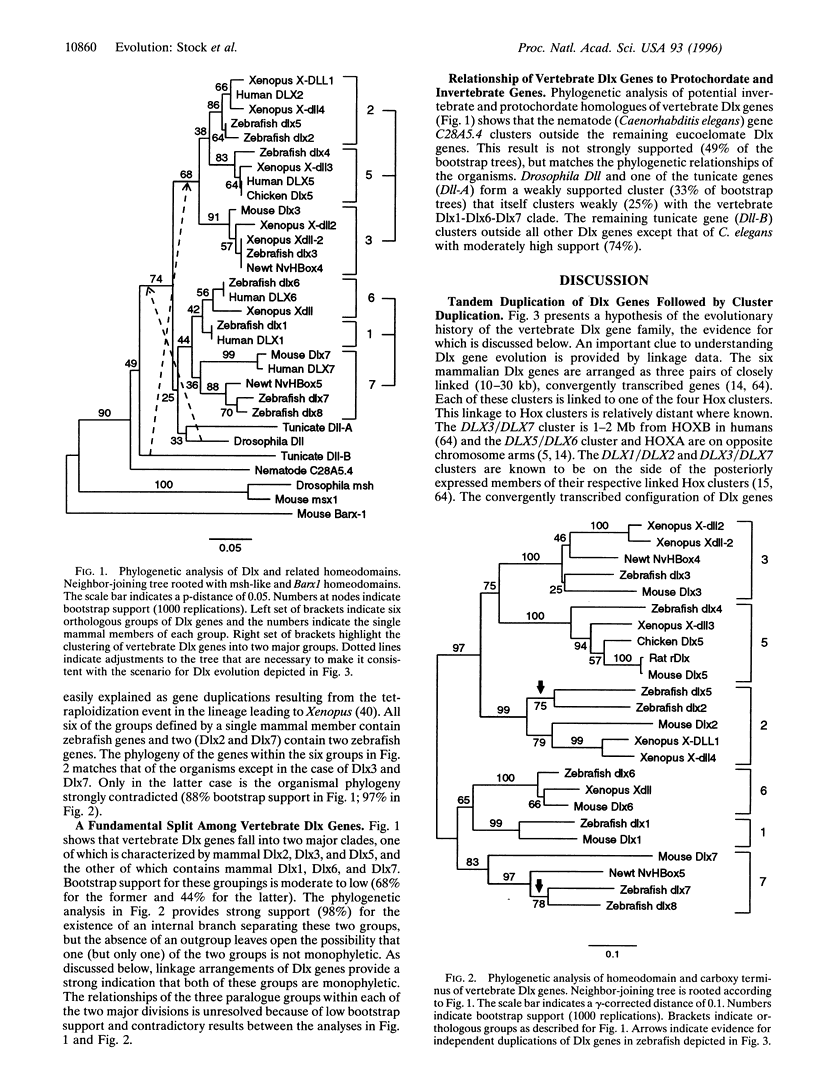
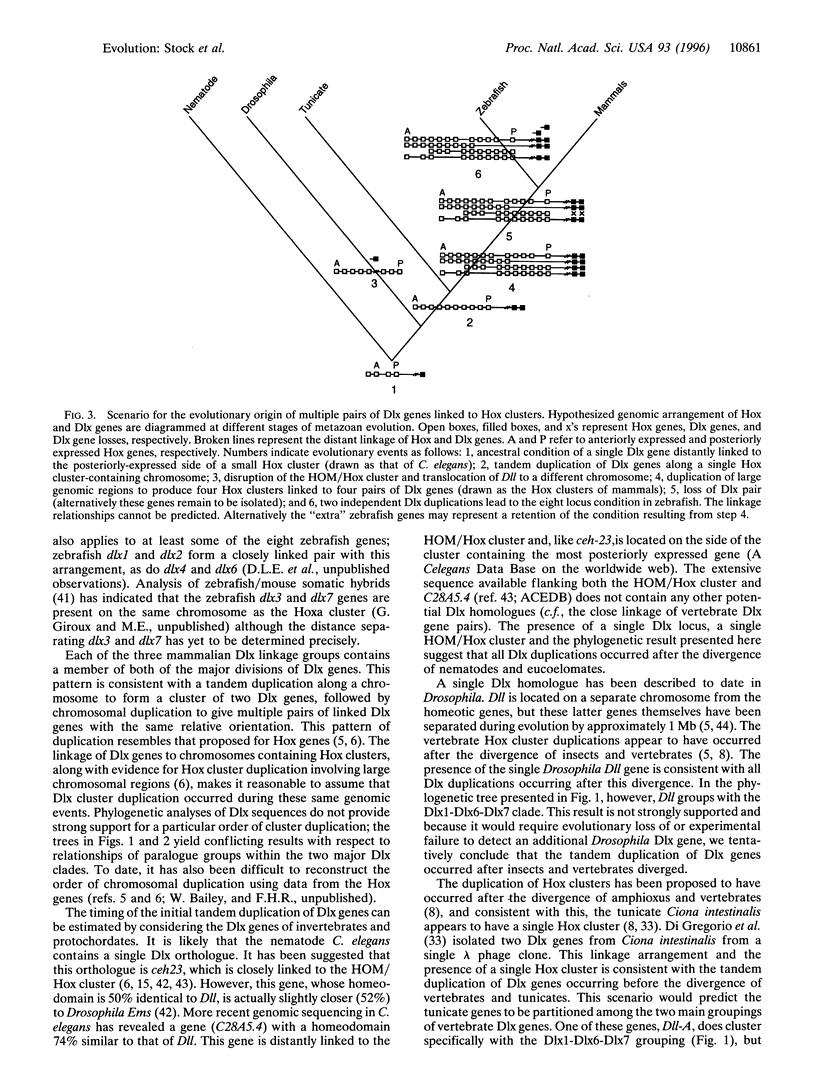
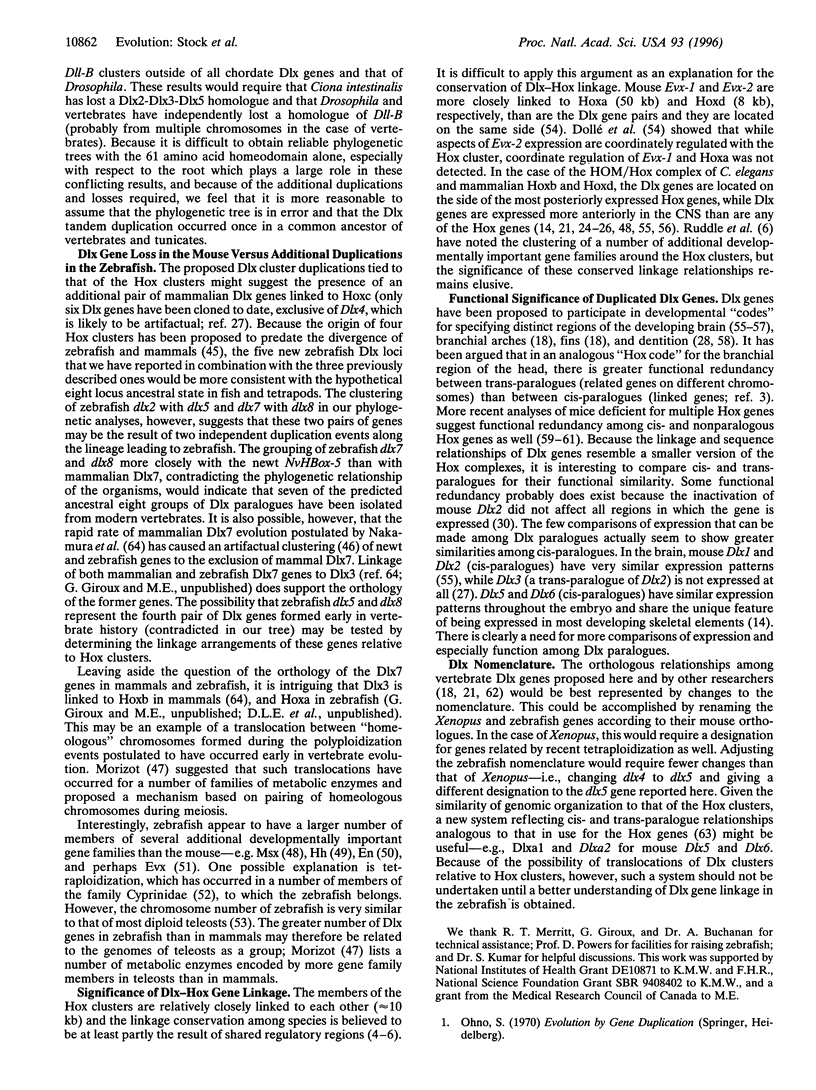
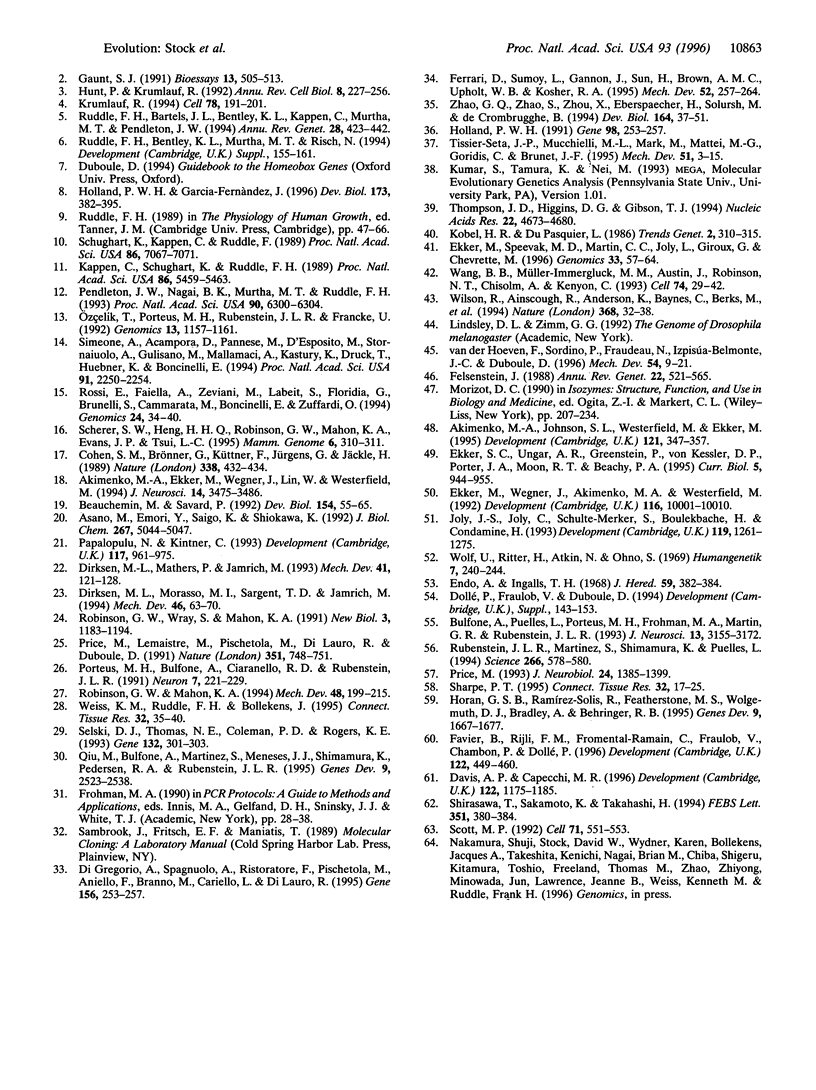
Selected References
These references are in PubMed. This may not be the complete list of references from this article.
- Akimenko M. A., Ekker M., Wegner J., Lin W., Westerfield M. Combinatorial expression of three zebrafish genes related to distal-less: part of a homeobox gene code for the head. J Neurosci. 1994 Jun;14(6):3475–3486. doi: 10.1523/JNEUROSCI.14-06-03475.1994. [DOI] [PMC free article] [PubMed] [Google Scholar]
- Akimenko M. A., Johnson S. L., Westerfield M., Ekker M. Differential induction of four msx homeobox genes during fin development and regeneration in zebrafish. Development. 1995 Feb;121(2):347–357. doi: 10.1242/dev.121.2.347. [DOI] [PubMed] [Google Scholar]
- Asano M., Emori Y., Saigo K., Shiokawa K. Isolation and characterization of a Xenopus cDNA which encodes a homeodomain highly homologous to Drosophila Distal-less. J Biol Chem. 1992 Mar 15;267(8):5044–5047. [PubMed] [Google Scholar]
- Beauchemin M., Savard P. Two distal-less related homeobox-containing genes expressed in regeneration blastemas of the newt. Dev Biol. 1992 Nov;154(1):55–65. doi: 10.1016/0012-1606(92)90047-k. [DOI] [PubMed] [Google Scholar]
- Bulfone A., Puelles L., Porteus M. H., Frohman M. A., Martin G. R., Rubenstein J. L. Spatially restricted expression of Dlx-1, Dlx-2 (Tes-1), Gbx-2, and Wnt-3 in the embryonic day 12.5 mouse forebrain defines potential transverse and longitudinal segmental boundaries. J Neurosci. 1993 Jul;13(7):3155–3172. doi: 10.1523/JNEUROSCI.13-07-03155.1993. [DOI] [PMC free article] [PubMed] [Google Scholar]
- Cohen S. M., Brönner G., Küttner F., Jürgens G., Jäckle H. Distal-less encodes a homoeodomain protein required for limb development in Drosophila. Nature. 1989 Mar 30;338(6214):432–434. doi: 10.1038/338432a0. [DOI] [PubMed] [Google Scholar]
- Davis A. P., Capecchi M. R. A mutational analysis of the 5' HoxD genes: dissection of genetic interactions during limb development in the mouse. Development. 1996 Apr;122(4):1175–1185. doi: 10.1242/dev.122.4.1175. [DOI] [PubMed] [Google Scholar]
- Di Gregorio A., Spagnuolo A., Ristoratore F., Pischetola M., Aniello F., Branno M., Cariello L., Di Lauro R. Cloning of ascidian homeobox genes provides evidence for a primordial chordate cluster. Gene. 1995 Apr 24;156(2):253–257. doi: 10.1016/0378-1119(95)00035-5. [DOI] [PubMed] [Google Scholar]
- Dirksen M. L., Mathers P., Jamrich M. Expression of a Xenopus Distal-less homeobox gene involved in forebrain and cranio-facial development. Mech Dev. 1993 May;41(2-3):121–128. doi: 10.1016/0925-4773(93)90042-v. [DOI] [PubMed] [Google Scholar]
- Dirksen M. L., Morasso M. I., Sargent T. D., Jamrich M. Differential expression of a Distal-less homeobox gene Xdll-2 in ectodermal cell lineages. Mech Dev. 1994 Apr;46(1):63–70. doi: 10.1016/0925-4773(94)90038-8. [DOI] [PubMed] [Google Scholar]
- Dollé P., Fraulob V., Duboule D. Developmental expression of the mouse Evx-2 gene: relationship with the evolution of the HOM/Hox complex. Dev Suppl. 1994:143–153. [PubMed] [Google Scholar]
- Ekker M., Speevak M. D., Martin C. C., Joly L., Giroux G., Chevrette M. Stable transfer of zebrafish chromosome segments into mouse cells. Genomics. 1996 Apr 1;33(1):57–64. doi: 10.1006/geno.1996.0159. [DOI] [PubMed] [Google Scholar]
- Ekker S. C., Ungar A. R., Greenstein P., von Kessler D. P., Porter J. A., Moon R. T., Beachy P. A. Patterning activities of vertebrate hedgehog proteins in the developing eye and brain. Curr Biol. 1995 Aug 1;5(8):944–955. doi: 10.1016/s0960-9822(95)00185-0. [DOI] [PubMed] [Google Scholar]
- Endo A., Ingalls T. H. Chromosomes of the zebra fish. A model for cytogenetic, embryologic, and ecologic study. J Hered. 1968 Nov-Dec;59(6):382–384. doi: 10.1093/oxfordjournals.jhered.a107755. [DOI] [PubMed] [Google Scholar]
- Favier B., Rijli F. M., Fromental-Ramain C., Fraulob V., Chambon P., Dollé P. Functional cooperation between the non-paralogous genes Hoxa-10 and Hoxd-11 in the developing forelimb and axial skeleton. Development. 1996 Feb;122(2):449–460. doi: 10.1242/dev.122.2.449. [DOI] [PubMed] [Google Scholar]
- Felsenstein J. Phylogenies from molecular sequences: inference and reliability. Annu Rev Genet. 1988;22:521–565. doi: 10.1146/annurev.ge.22.120188.002513. [DOI] [PubMed] [Google Scholar]
- Ferrari D., Sumoy L., Gannon J., Sun H., Brown A. M., Upholt W. B., Kosher R. A. The expression pattern of the Distal-less homeobox-containing gene Dlx-5 in the developing chick limb bud suggests its involvement in apical ectodermal ridge activity, pattern formation, and cartilage differentiation. Mech Dev. 1995 Aug;52(2-3):257–264. doi: 10.1016/0925-4773(95)98113-o. [DOI] [PubMed] [Google Scholar]
- Gaunt S. J. Expression patterns of mouse Hox genes: clues to an understanding of developmental and evolutionary strategies. Bioessays. 1991 Oct;13(10):505–513. doi: 10.1002/bies.950131004. [DOI] [PubMed] [Google Scholar]
- Holland P. W. Cloning and evolutionary analysis of msh-like homeobox genes from mouse, zebrafish and ascidian. Gene. 1991 Feb 15;98(2):253–257. doi: 10.1016/0378-1119(91)90182-b. [DOI] [PubMed] [Google Scholar]
- Holland P. W., Garcia-Fernàndez J. Hox genes and chordate evolution. Dev Biol. 1996 Feb 1;173(2):382–395. doi: 10.1006/dbio.1996.0034. [DOI] [PubMed] [Google Scholar]
- Horan G. S., Ramírez-Solis R., Featherstone M. S., Wolgemuth D. J., Bradley A., Behringer R. R. Compound mutants for the paralogous hoxa-4, hoxb-4, and hoxd-4 genes show more complete homeotic transformations and a dose-dependent increase in the number of vertebrae transformed. Genes Dev. 1995 Jul 1;9(13):1667–1677. doi: 10.1101/gad.9.13.1667. [DOI] [PubMed] [Google Scholar]
- Hunt P., Krumlauf R. Hox codes and positional specification in vertebrate embryonic axes. Annu Rev Cell Biol. 1992;8:227–256. doi: 10.1146/annurev.cb.08.110192.001303. [DOI] [PubMed] [Google Scholar]
- Joly J. S., Joly C., Schulte-Merker S., Boulekbache H., Condamine H. The ventral and posterior expression of the zebrafish homeobox gene eve1 is perturbed in dorsalized and mutant embryos. Development. 1993 Dec;119(4):1261–1275. doi: 10.1242/dev.119.4.1261. [DOI] [PubMed] [Google Scholar]
- Kappen C., Schughart K., Ruddle F. H. Two steps in the evolution of Antennapedia-class vertebrate homeobox genes. Proc Natl Acad Sci U S A. 1989 Jul;86(14):5459–5463. doi: 10.1073/pnas.86.14.5459. [DOI] [PMC free article] [PubMed] [Google Scholar]
- Krumlauf R. Hox genes in vertebrate development. Cell. 1994 Jul 29;78(2):191–201. doi: 10.1016/0092-8674(94)90290-9. [DOI] [PubMed] [Google Scholar]
- Ozçelik T., Porteus M. H., Rubenstein J. L., Francke U. DLX2 (TES1), a homeobox gene of the Distal-less family, assigned to conserved regions on human and mouse chromosomes 2. Genomics. 1992 Aug;13(4):1157–1161. doi: 10.1016/0888-7543(92)90031-m. [DOI] [PubMed] [Google Scholar]
- Papalopulu N., Kintner C. Xenopus Distal-less related homeobox genes are expressed in the developing forebrain and are induced by planar signals. Development. 1993 Mar;117(3):961–975. doi: 10.1242/dev.117.3.961. [DOI] [PubMed] [Google Scholar]
- Pendleton J. W., Nagai B. K., Murtha M. T., Ruddle F. H. Expansion of the Hox gene family and the evolution of chordates. Proc Natl Acad Sci U S A. 1993 Jul 1;90(13):6300–6304. doi: 10.1073/pnas.90.13.6300. [DOI] [PMC free article] [PubMed] [Google Scholar]
- Porteus M. H., Bulfone A., Ciaranello R. D., Rubenstein J. L. Isolation and characterization of a novel cDNA clone encoding a homeodomain that is developmentally regulated in the ventral forebrain. Neuron. 1991 Aug;7(2):221–229. doi: 10.1016/0896-6273(91)90260-7. [DOI] [PubMed] [Google Scholar]
- Price M., Lemaistre M., Pischetola M., Di Lauro R., Duboule D. A mouse gene related to Distal-less shows a restricted expression in the developing forebrain. Nature. 1991 Jun 27;351(6329):748–751. doi: 10.1038/351748a0. [DOI] [PubMed] [Google Scholar]
- Price M. Members of the Dlx- and Nkx2-gene families are regionally expressed in the developing forebrain. J Neurobiol. 1993 Oct;24(10):1385–1399. doi: 10.1002/neu.480241010. [DOI] [PubMed] [Google Scholar]
- Qiu M., Bulfone A., Martinez S., Meneses J. J., Shimamura K., Pedersen R. A., Rubenstein J. L. Null mutation of Dlx-2 results in abnormal morphogenesis of proximal first and second branchial arch derivatives and abnormal differentiation in the forebrain. Genes Dev. 1995 Oct 15;9(20):2523–2538. doi: 10.1101/gad.9.20.2523. [DOI] [PubMed] [Google Scholar]
- Robinson G. W., Mahon K. A. Differential and overlapping expression domains of Dlx-2 and Dlx-3 suggest distinct roles for Distal-less homeobox genes in craniofacial development. Mech Dev. 1994 Dec;48(3):199–215. doi: 10.1016/0925-4773(94)90060-4. [DOI] [PubMed] [Google Scholar]
- Robinson G. W., Wray S., Mahon K. A. Spatially restricted expression of a member of a new family of murine Distal-less homeobox genes in the developing forebrain. New Biol. 1991 Dec;3(12):1183–1194. [PubMed] [Google Scholar]
- Rossi E., Faiella A., Zeviani M., Labeit S., Floridia G., Brunelli S., Cammarata M., Boncinelli E., Zuffardi O. Order of six loci at 2q24-q31 and orientation of the HOXD locus. Genomics. 1994 Nov 1;24(1):34–40. doi: 10.1006/geno.1994.1579. [DOI] [PubMed] [Google Scholar]
- Rubenstein J. L., Martinez S., Shimamura K., Puelles L. The embryonic vertebrate forebrain: the prosomeric model. Science. 1994 Oct 28;266(5185):578–580. doi: 10.1126/science.7939711. [DOI] [PubMed] [Google Scholar]
- Ruddle F. H., Bartels J. L., Bentley K. L., Kappen C., Murtha M. T., Pendleton J. W. Evolution of Hox genes. Annu Rev Genet. 1994;28:423–442. doi: 10.1146/annurev.ge.28.120194.002231. [DOI] [PubMed] [Google Scholar]
- Ruddle F. H., Bentley K. L., Murtha M. T., Risch N. Gene loss and gain in the evolution of the vertebrates. Dev Suppl. 1994:155–161. [PubMed] [Google Scholar]
- Scherer S. W., Heng H. H., Robinson G. W., Mahon K. A., Evans J. P., Tsui L. C. Assignment of the human homolog of mouse Dlx3 to chromosome 17q21.3-q22 by analysis of somatic cell hybrids and fluorescence in situ hybridization. Mamm Genome. 1995 Apr;6(4):310–311. doi: 10.1007/BF00352432. [DOI] [PubMed] [Google Scholar]
- Schughart K., Kappen C., Ruddle F. H. Duplication of large genomic regions during the evolution of vertebrate homeobox genes. Proc Natl Acad Sci U S A. 1989 Sep;86(18):7067–7071. doi: 10.1073/pnas.86.18.7067. [DOI] [PMC free article] [PubMed] [Google Scholar]
- Scott M. P. Vertebrate homeobox gene nomenclature. Cell. 1992 Nov 13;71(4):551–553. doi: 10.1016/0092-8674(92)90588-4. [DOI] [PubMed] [Google Scholar]
- Selski D. J., Thomas N. E., Coleman P. D., Rogers K. E. The human brain homeogene, DLX-2: cDNA sequence and alignment with the murine homologue. Gene. 1993 Oct 15;132(2):301–303. doi: 10.1016/0378-1119(93)90212-l. [DOI] [PubMed] [Google Scholar]
- Sharpe P. T. Homeobox genes and orofacial development. Connect Tissue Res. 1995;32(1-4):17–25. doi: 10.3109/03008209509013701. [DOI] [PubMed] [Google Scholar]
- Shirasawa T., Sakamoto K., Tkahashi H. Molecular cloning and evolutional analysis of a mammalian homologue of the Distal-less 3 (Dlx-3) homeobox gene. FEBS Lett. 1994 Sep 12;351(3):380–384. doi: 10.1016/0014-5793(94)00896-5. [DOI] [PubMed] [Google Scholar]
- Simeone A., Acampora D., Pannese M., D'Esposito M., Stornaiuolo A., Gulisano M., Mallamaci A., Kastury K., Druck T., Huebner K. Cloning and characterization of two members of the vertebrate Dlx gene family. Proc Natl Acad Sci U S A. 1994 Mar 15;91(6):2250–2254. doi: 10.1073/pnas.91.6.2250. [DOI] [PMC free article] [PubMed] [Google Scholar]
- Thompson J. D., Higgins D. G., Gibson T. J. CLUSTAL W: improving the sensitivity of progressive multiple sequence alignment through sequence weighting, position-specific gap penalties and weight matrix choice. Nucleic Acids Res. 1994 Nov 11;22(22):4673–4680. doi: 10.1093/nar/22.22.4673. [DOI] [PMC free article] [PubMed] [Google Scholar]
- Tissier-Seta J. P., Mucchielli M. L., Mark M., Mattei M. G., Goridis C., Brunet J. F. Barx1, a new mouse homeodomain transcription factor expressed in cranio-facial ectomesenchyme and the stomach. Mech Dev. 1995 May;51(1):3–15. doi: 10.1016/0925-4773(94)00343-l. [DOI] [PubMed] [Google Scholar]
- Wang B. B., Müller-Immergluck M. M., Austin J., Robinson N. T., Chisholm A., Kenyon C. A homeotic gene cluster patterns the anteroposterior body axis of C. elegans. Cell. 1993 Jul 16;74(1):29–42. doi: 10.1016/0092-8674(93)90292-x. [DOI] [PubMed] [Google Scholar]
- Weiss K. M., Ruddle F. H., Bollekens J. Dlx and other homeobox genes in the morphological development of the dentition. Connect Tissue Res. 1995;32(1-4):35–40. doi: 10.3109/03008209509013703. [DOI] [PubMed] [Google Scholar]
- Wilson R., Ainscough R., Anderson K., Baynes C., Berks M., Bonfield J., Burton J., Connell M., Copsey T., Cooper J. 2.2 Mb of contiguous nucleotide sequence from chromosome III of C. elegans. Nature. 1994 Mar 3;368(6466):32–38. doi: 10.1038/368032a0. [DOI] [PubMed] [Google Scholar]
- Wolf U., Ritter H., Atkin N. B., Ohno S. Polyploidization in the fish family Cyprinidae, order Cypriniformes. I. DNA-content and chromosome sets in various species of Cyprinidae. Humangenetik. 1969;7(3):240–244. doi: 10.1007/BF00273173. [DOI] [PubMed] [Google Scholar]
- Zhao G. Q., Zhao S., Zhou X., Eberspaecher H., Solursh M., de Crombrugghe B. rDlx, a novel distal-less-like homeoprotein is expressed in developing cartilages and discrete neuronal tissues. Dev Biol. 1994 Jul;164(1):37–51. doi: 10.1006/dbio.1994.1178. [DOI] [PubMed] [Google Scholar]
- van der Hoeven F., Sordino P., Fraudeau N., Izpisúa-Belmonte J. C., Duboule D. Teleost HoxD and HoxA genes: comparison with tetrapods and functional evolution of the HOXD complex. Mech Dev. 1996 Jan;54(1):9–21. doi: 10.1016/0925-4773(95)00455-6. [DOI] [PubMed] [Google Scholar]


